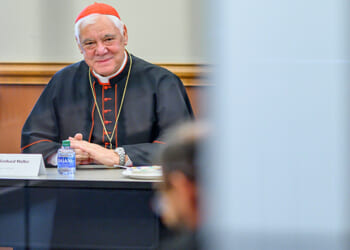My father is a reverent man. Not in the incense-swinging, Latin-chanting, cassock-donning kind of way—though he’d probably volunteer for all three if asked—but in the unmistakable, sometimes exasperating way that says: this matters. Whether it was praying before dinner or dressing for Mass, his posture told the world something sacred was happening—even if the cathedral happened to be a station wagon on the way to my grandparents’ in Dubuque, Iowa, and the only other parishioners were cows in a field—who, no matter the weather, merited Dad’s window rolled down and his loudest, most full-throated “Moooooo!”
When asked to lector, his voice rose like the archangel’s trumpet—often preceded by a few unbidden remarks, to the visible discomfort of the presider. More recently, when we invited him to lead Morning Prayer from the Liturgy of the Hours, he deviated so far into personal commentary that by the time we returned to the prescribed psalm, we weren’t sure whether we were in Tuesday of Week II or at a backyard revival.
We kids called this “Bernie-izing,” in honor of our dad, Bernie. Bernie-izing is the art of transforming the mundane into the eternal—with a few sidebars along the way. Beneath the eyerolls and amused smirks, there was always this lingering truth: he wasn’t wrong to believe sacred things deserve intentionality. He knew God mattered.
My father’s reverence was sincere—but it was also his. When offered the Church’s public prayer, he wanted to make it personal. Which is essential by intention but misplaced by form. It came from a good place. But it revealed something essential we are in danger of losing: a right ordering of ourselves—not just as individuals, but as a people—toward God and one another. This is about the divine architecture of communion, something greater than personal preference, that forms the path to our greatest flourishing. Put simply: our reception of Holy Communion is ordered toward our participation in holy community—and that demands we extend beyond the private cell of our own preferences, feelings, or style.
The guiding value here is reverence. Reverence is not merely what we feel. It is not anchored in personal preference or subjective inclination. Reverence is how we respond—rightly, communally, bodily—to what is revealed. To what is real. In a culture that treats a shallow version of “authenticity” as ultimate, this truth is quietly, perilously fading.
What Reverence Really Is—and Why It Matters
We live in a time when feeling has become king. If I don’t feel it, it isn’t real. If it doesn’t move me, it doesn’t matter. If it doesn’t suit me, it must be oppressive. Reverence, in this climate, can seem quaint—like a costume we wear rather than a truth we enter.
But reverence is not nostalgia. It is the posture of the soul before the Real. It is the recognition that I am not the center, that I do not invent meaning, and that love is not formless—it has a shape.
In the Christian tradition, reverence is not performance. It is participation. It is how the finite enters communion with the Infinite—not on our terms, but on God’s. And that’s why reverence always involves form: words we did not write, gestures we did not invent, habits that don’t begin with us but are meant to form us.
We don’t reverence something because we feel it is holy. We reverence it because it is holy—and in so doing, we begin to feel rightly.
The Forgotten Difference: Public Prayer vs. Private Prayer
While it’s true that many observant Catholics could awaken more deeply to the personal intimacy Christ describes as essential to salvation—the ginosko of Matthew 11, that profound, relational knowing that surpasses mere observance—for others, the confusion lies in collapsing all prayer into a single category: something personal, spontaneous, and expressive. And in many ways, private prayer should be exactly that—raw, intimate, heartfelt.
But public prayer is different. It isn’t about self-expression. It’s about shared offering. When we gather as a Church, we are not improvising. We are entering something larger. Anchored in and flowing from the Church Christ established nearly two millennia ago, the prayers of the Mass, the psalms of the Divine Office, the gestures, the silence—they are not about “what I feel in the moment.” They are about Whose we are becoming together.
As the Catechism affirms, “Liturgy is an action of the whole Christ”—not a platform for personal inspiration, but the self-offering of Christ through His Body, the Church (CCC 1136). It is here that reverence becomes not just personal but communal. It invites me to surrender my preferences for the sake of a greater harmony. It teaches me to bend, to bow, to listen, to wait. And these habits do not end when the liturgy does. They begin there.
What Liturgy Forms in Us
And that’s why reverence must be learned—and liturgy is its school.
Dietrich von Hildebrand, in Liturgy and Personality, wrote that liturgy does not suppress the self—it forms the self. It draws us into relationship, into right worship, into a truth that transcends personal taste.
Pope Benedict XVI wrote, “The greatness of the liturgy depends—we shall have to repeat this frequently—on its unspontaneity.” It is precisely because the liturgy is not our own that it can lift us beyond ourselves. We are not the authors. We are the participants.
Frank Sheed put it even more clearly: to see the world rightly—to be sane—is to see it as God-bathed. Liturgy trains us to see. Reverence teaches us to love what we do not yet fully understand.
Christ Himself didn’t abolish form. He fulfilled it. He kept the feasts. He read in the synagogue. He reclined at table—and then transformed that table into an altar. The Last Supper wasn’t a spontaneous potluck of goodwill. It was the Passover—fulfilled. Gesture, form, tradition—they mattered to Him. They must matter to us.
Reverence in the Small Things
So, when a child asks why they must dress nicely for Mass, or kneel, or fold their hands, they’re not just resisting decorum. They’re asking something profound: Do my actions shape who I become? And the answer is yes.
St. Josemaría Escrivá said it plainly: “Great holiness consists in carrying out the little duties of each moment.” What we do forms what we love.
The word worship comes from the Old English weorthscipe—to ascribe worth or value. To worship, then, is to give something its due. And if all of creation is a reflection—a refulgence—of its Creator, then true worship necessarily extends beyond the sanctuary. It encompasses every aspect of life. It shows up in how we speak. In how we text. In whether we arrive on time. In how we listen—or fail to. In whether we keep our word or cancel at whim. When our lives are dictated by impulse, we become people who can no longer reverence anything—because we have forgotten how to recognize worth.
Reverence is what anchors love. It says: you matter enough for me to show up, to be quiet, to bow, to stay. This is worship extended to the dinner table. To the group text. To the bedside. To the funeral. To the conversation we’d rather avoid.
Why We Need Reverence to Belong
When we fail to stretch beyond our personal silos—when we elevate feeling as the supreme arbiter of truth—we don’t just become fragmented; we become fundamentally alone. Our capacity to belong—to God, to others, even to ourselves—quietly disintegrates. Reverence, rightly understood, is what pulls us out of ourselves. It roots us in a reality greater than impulse. It forms a bridge between the individual and the eternal. And when we lose it, we don’t just forget what we’re doing. We begin to forget who we are.
Consider the London Blitz during World War II. Had the people of London chosen to stay isolated in their fear and despair—if they had trusted only their own feelings, refused to emerge, and attempted to go it alone—the result could have been societal collapse. But that’s not what happened. They gathered. They sang. They prayed in bomb shelters and passed tin cups of tea. They dug strangers from rubble. They embraced reverence—not as ritual piety, but as shared sacrifice and meaning.
Their catastrophe became communion.
In Tribe, Sebastian Junger observes that depression rates actually dropped during the Blitz. Why? Because people belonged. They had purpose. They were bound together by something greater than themselves. Similarly, sociologist Émile Durkheim, in Suicide: A Study in Sociology, observed that suicide rates tend to decrease during times of war or communal hardship. When individuals experience themselves as part of a meaningful whole—when they are drawn into reverent participation in a shared reality—they are less prone to despair.
This is what reverence does. It integrates us. It gives us place. It offers not infinite choice, but something far better: a role in the chorus.
Liturgy does the same. As the Catechism teaches, “The liturgy is the summit toward which the activity of the Church is directed, and the font from which all her power flows” (CCC 1074). We are not the source—we are the ones being drawn in.
Liturgy teaches us that love has a language. That communion has a choreography. That truth has a form. And when we step into it—together—we are not stifled. We are sanctified.
The Hat and the Curtain
Chesterton said repetition isn’t boredom—it’s the Creator’s joy. “Do it again,” He says, like a child delighting in the fifteenth “airplane ride.” So too with the Mass. And the Divine Office. Or the simple but most formidable pronouncement, “I love you.” So too with every reverent gesture we repeat—not to go through the motions, but to be formed by them.
When we stand for the national anthem, or remove a hat at the dinner table, we are not just playing a part. We are saying: this matters. When we genuflect, bow, fold our hands, or speak the words given to us—we are not being less authentic. We are being more human.
Some might scoff at that. What does a hat or a curtain have to do with reverence?
Everything.
When Christ died, the veil in the Temple was torn—not to destroy reverence, but to open it to the world. Heaven came to meet us. But we must still respond rightly—not casually, not creatively, but with awe.
St. Augustine reminds us, “We are not the measure of truth; truth is the measure of us.” The torn curtain wasn’t an invitation to collapse the sacred. It was an invitation to enter it—on God’s terms.
Reverence as Resistance
In an age of casualness, reverence is resistance. It says: I will not live by impulse. I will not worship what flatters me. I will not reduce love to a feeling, or worship to a show.
I will bow. I will wait. I will learn to love the form before I feel the fire.
And in that, I will become more—not less—of who I was made to be.
Because reverence isn’t about us.
It’s about God.
It’s about stepping into the song He’s been singing from before time began. It is the torn curtain and the removed hat—heaven opened, and the soul bowed low.
And that, as my dad would say—with hands folded, head bowed, and maybe even a reverent moo—is worth kneeling for.
Photo by Valentin Lacoste on Unsplash















